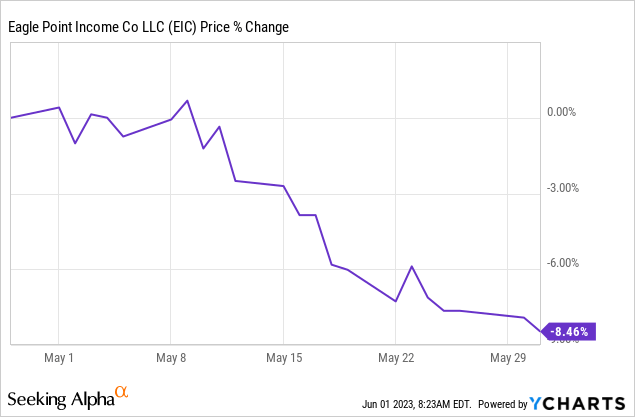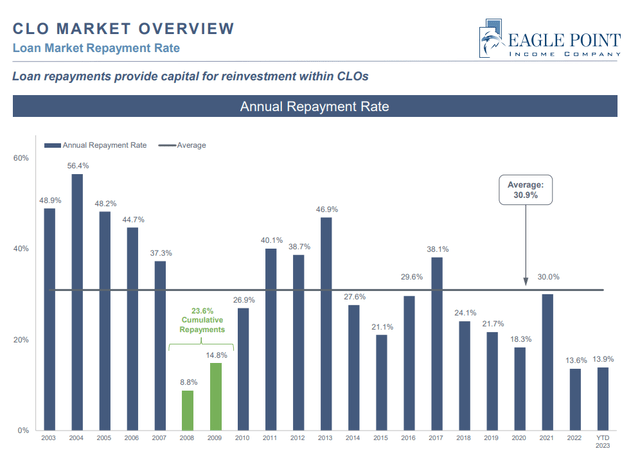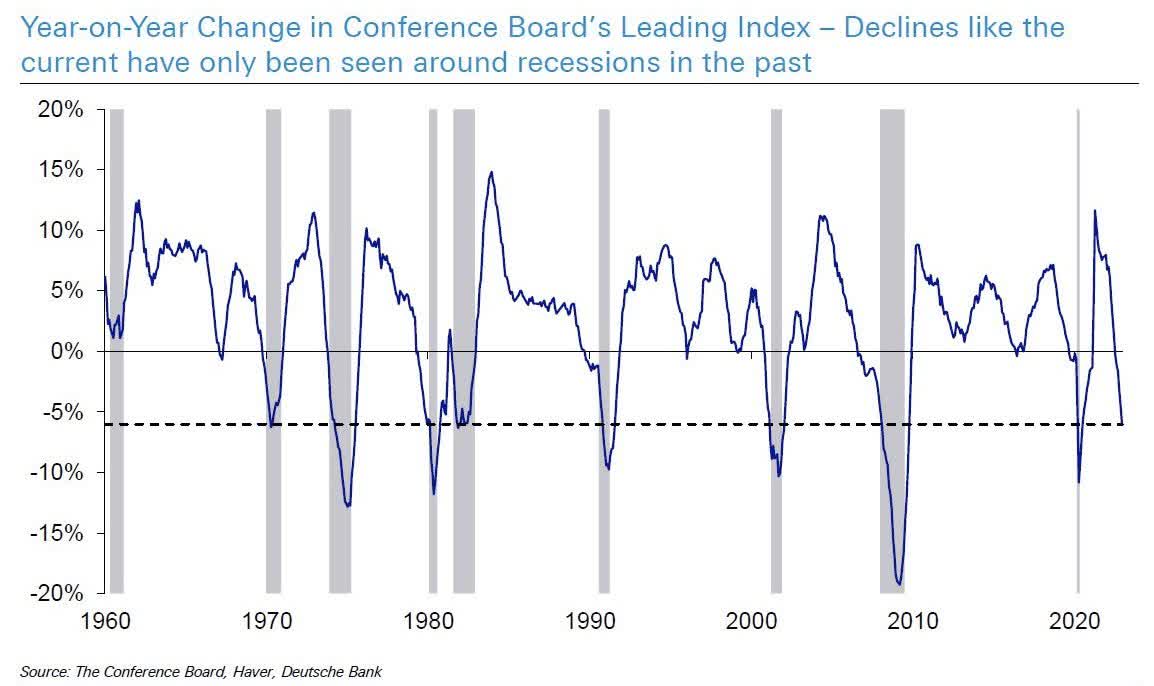Eagle Point Income Co Inc (NYSE:EIC) has not given you any returns since inception. What started out as a “conservative” take on collateralized loan obligations has lost out to Treasury bills. What happened here and where does this fund go next? We take a look at this and see if you have a mean reversion setup or whether you should hit the bid.
The Returns
You will find a few different numbers for returns on this fund. While all of them are bad, we want to show you how they are calculated so investors understand where the differences come from. The easiest number to access is the one on the company website. Note that this is for April 30, 2023 and we are about one month behind today.

EIC Website
This one is done reinvesting all distributions, but the twist here versus metrics found on other sites is that the distributions are reinvested at a discount. To the best of our knowledge, all other automatic calculators assume distribution at the market price. Since EIC generally has traded a premium, those sites will understate the total return. Hence the company’s presentation is the very best outcome one can get with distributions reinvested.
That outcome shows 8.27% since IPO. Of course that outcome takes a $14.78 closing price. EIC is down since April 30, 2023 falling by 8.46%.

We did get one distribution since then, but this is about as close to a 0% total return as you can get over 46 months (inception July 2019).
Many funds in this space have dramatically different returns depending on whether you had reinvested the distributions or not. Interestingly, this is one of those cases where if we investors consumed the distributions, then the total return is almost identical. Buy Upside calculates this as about 0% total since inception.

Buy Upside
Your Returns
If you had this in a taxable account, your total returns would drop significantly from the 0% shown above. The bulk of the distributions have come as ordinary income and taxes would really reach deep into your pocket, even if you reinvested the income.

EIC Website
What Happened?
EIC started off in 2019 and was designed to give you exposure to BB rated CLOs. Note that this slide is from their 2019 presentation.

EIC 2019 Presentation
Across most measures, the default rate for CLOs was pretty low in the last four years. You can see the data for 2021 below.
Corporate defaults in 2021 were unlikely to drag much on CLO performance, given half of the corporate entities that defaulted in 2021 were rated within the lowest rating levels, ‘CCC+’ and lower, at which CLO managers tend to limit their credit exposures. Meanwhile, the ‘B’ category (which is much more broadly held within CLOs) showed a default rate of just 0.52%, considerably lower than its long-term weighted average of 3.18%.
Source: S&P Global
In fact the same article has a picture of CLO defaults versus other forms of debt and goes to show that even during 2020, the results were quite good for this asset class.
S&P Global
So whatever EIC delivered, we cannot blame it on lower rated CLOs in general.
There are two reasons here that could explain the performance.
1) The fund generally had bad picks relative to the index.
2) The pricing of its CLOs is abnormally depressed and offers substantial room for recovery.
If you ask the bulls, it is always the case that any CLO fund or mortgage REIT that delivers really poor returns is facing abnormally bad pricing. It is always sunny in Philadelphia and it is always a good time to buy. We are skeptical of this explanation here for two reasons. The first being that these funds hold CLOs that have relatively short durations (they pay out quickly). If you own a CLO maturing in four years, at the end of four years you have a final outcome. There is zero room for pricing “being off” at that time point. An extension of that is that pricing cannot be too far away from the truth when the fund is holding relatively short duration debt and has pretty substantial prepayments every year.

EIC Q1-2023 Presentation
So the disappointment from the fund comes from bad picks and the CLO asset class delivering less than advertised.
Outlook
The hard data continues to support a recession having started or being awfully close. GDI (an alternate measure similar to GDP) contracted in Q4-2022 and Q1-2023. LEI’s have been contracting for several months in a row.

Deutsche Bank
Chicago PMI printed at 40.4, which has not happened outside of a recession. Most retailers have been reducing guidance extremely briskly. Victoria’s Secret (VSCO) for example changed their 2023 sales guidance in one quarter from up 6-8% to down 2-4%. Their Q4-2022 results were in early March so they had one quarter pretty much in the bag when they guided for 6-8% up. We have a lot of retailers fitting this profile.

This fits with the economy falling off the cliff in Q2 which we are hearing about in multiple reports. We don’t think high yield debt is properly pricing in the risks and the same goes for CLOs and the funds associated. For EIC we think 5% annual total returns are probable given the asset class over the next two years. So more NAV declines that partially offset the income.
Alternatives
One place where investors can get good yields with lower risk are in the preferred shares of these same CLO funds. Eagle Point Credit Company Inc – 6.75% PRF PERPETUAL USD 25 (ECC.PD) belonging to sister company Eagle Point Credit (ECC) has an 8.44% yield currently. There are safety nets in place for Closed end funds and they have to maintain an enhanced asset coverage for the preferred shares and baby bonds at all times. We will wager that this yield outperforms the total return on EIC as well as ECC from here.
Another alternative would be shop for quality bonds that punch above their weight class. Since we are sticking with the credit theme, Owl Rock Capital (ORCC) is one that comes out ahead in our screening. Near term bonds such as the one maturing on July 22 2025, offer 7.5% yield to Maturity. These are investment grade bonds which yield far more than the average two-year investment-grade bond. Obviously the market sees some relatively higher risks, but with ORCC’s liquidity profile and backing of parent Blue Owl Capital Inc. (OWL), we think the bonds should be bulletproof.
Please note that this is not financial advice. It may seem like it, sound like it, but surprisingly, it is not. Investors are expected to do their own due diligence and consult with a professional who knows their objectives and constraints.
Editor’s Note: This article covers one or more microcap stocks. Please be aware of the risks associated with these stocks.
Read the full article here












